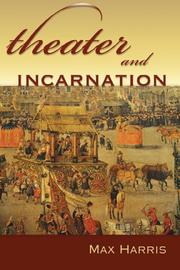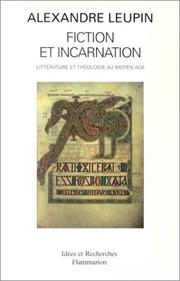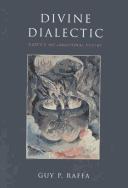| Listing 1 - 6 of 6 |
Sort by
|

ISBN: 080282837X 080282837X 9780802828378 Year: 2005 Publisher: Grand Rapids: Eerdmans,
Abstract | Keywords | Export | Availability | Bookmark
 Loading...
Loading...Choose an application
- Reference Manager
- EndNote
- RefWorks (Direct export to RefWorks)
Theater --- Religion and drama --- Incarnation in literature
Book
ISBN: 9791037010674 Year: 2017 Publisher: Paris (6, rue de la Sorbonne 75005) : Hermann,
Abstract | Keywords | Export | Availability | Bookmark
 Loading...
Loading...Choose an application
- Reference Manager
- EndNote
- RefWorks (Direct export to RefWorks)
L'Incarnation fascine la France et toute l'Europe de la première moitié du XVIIe siècle. Mystère du Verbe fait chair, de l'union du divin avec l'humain et de la venue de Dieu sur terre – selon la triple définition des théologiens de l'époque – mais aussi, plus simplement, récit rapporté par les évangiles de Matthieu et de Luc, elle se présente tout à la fois comme un sujet de réflexion théologique et de méditation morale, une vérité défendue contre les hérésies et une source de spiritualités nouvelles. Plus singulièrement, elle habite le roman comique qui se constitue comme genre, de la Première journée (1623) de Théophile de Viau et l'Histoire comique de Francion (1623) de Charles Sorel au Roman comique (1652/1657) de Paul Scarron et jusqu'aux États et empires de la Lune (1657) et du Soleil (1662) de Cyrano de Bergerac. Mise en roman, l'Incarnation y devient un para-dogme, c'est-à-dire un paradoxe au sens étymologique : non pas qu'elle s'oppose au dogme, mais bien plus qu'elle se place à côté, à distance, dans un espace différent, institutionnellement moins marqué, plus libre d'en exploiter le potentiel. Centrée sur une période particulièrement riche pour l'histoire du roman, de la théologie et des interactions entre l'un et l'autre, cette thèse propose au lecteur de suivre ce déplacement paradogmatique.
French fiction --- Incarnation in literature. --- Comic, The, in literature. --- History and criticism.
Book
ISBN: 0812207475 0812244516 1322511357 Year: 2012 Publisher: University of Pennsylvania Press
Abstract | Keywords | Export | Availability | Bookmark
 Loading...
Loading...Choose an application
- Reference Manager
- EndNote
- RefWorks (Direct export to RefWorks)
The Gospel of John describes the Incarnation of Christ as "the Word made flesh"-an intriguing phrase that uses the logic of metaphor but is not traditionally understood as merely symbolic. Thus the conceptual puzzle of the Incarnation also draws attention to language and form: what is the Word; how is it related to language; how can the Word become flesh? Such theological questions haunt the material imagery engaged by medieval writers, the structural forms that give their writing shape, and even their ideas about language itself. In Poetics of the Incarnation, Cristina Maria Cervone examines the work of fourteenth-century writers who, rather than approaching the mystery of the Incarnation through affective identification with the Passion, elected to ponder the intellectual implications of the Incarnation in poetical and rhetorical forms. Cervone argues that a poetics of the Incarnation becomes the grounds for working through the philosophical and theological implications of language, at a point in time when Middle English was emerging as a legitimate, if contested, medium for theological expression. In brief lyrics and complex narratives, late medieval English writers including William Langland, Julian of Norwich, Walter Hilton, and the anonymous author of the Charters of Christ took the relationship between God and humanity as a jumping-off point for their meditations on the nature of language and thought, the elision between the concrete and the abstract, the complex relationship between acting and being, the work done by poetry itself in and through time, and the meaning latent within poetical forms. Where Passion-devoted writing would focus on the vulnerability and suffering of the fleshly body, these texts took imaginative leaps, such as when they depict the body of Christ as a lily or the written word. Their Incarnational poetics repeatedly call attention to the fact that, in theology as in poetics, form matters.
Christian poetry, English (Middle) --- Incarnation in literature. --- Poetics --- History and criticism. --- History --- Cultural Studies. --- Literature. --- Medieval and Renaissance Studies.
Book
ISBN: 9789004300507 9004300503 9004300511 9789004300514 Year: 2015 Volume: 39 Publisher: Leiden: Brill,
Abstract | Keywords | Export | Availability | Bookmark
 Loading...
Loading...Choose an application
- Reference Manager
- EndNote
- RefWorks (Direct export to RefWorks)
The doctrine of the Incarnation was wellspring and catalyst for theories of images verbal, material, and spiritual. Section I, “Representing the Mystery of the Incarnation”, takes up questions about the representability of the mystery. Section II, “Imago Dei and the Incarnate Word”, investigates how Christ’s status as the image of God was seen to license images material and spiritual. Section III, “Literary Figurations of the Incarnation”, considers the verbal production of images contemplating the divine and human nature of Christ. Section IV, “Tranformative Analogies of Matter and Spirit”, delves into ways that material properties and processes, in their effects on the beholder, were analogized to Christ’s hypostasis. Section V, “Visualizing the Flesh of Christ”, considers the relation between the Incarnation and the Passion.
iconography --- Thematology --- theology --- Iconography --- Incarnation. --- Incarnation in art. --- Incarnation in literature --- Image of God. --- Incarnation --- Incarnation dans l'art --- Incarnation dans la littérature --- Image de Dieu --- Incarnation in art --- Image of God --- Incarnation dans la littérature --- Incarnation in literature. --- Kenosis (Theology) --- God --- God, Image of --- Image (Theology) --- Theological anthropology --- Image

ISBN: 208012627X 9782080126276 Year: 1994 Publisher: Paris: Flammarion,
Abstract | Keywords | Export | Availability | Bookmark
 Loading...
Loading...Choose an application
- Reference Manager
- EndNote
- RefWorks (Direct export to RefWorks)
Religion and literature --- Theology --- Incarnation in literature --- Literature, Medieval --- History --- History and criticism --- -Religion and literature --- -Theology --- -Christian theology --- Theology, Christian --- Christianity --- Religion --- Literature --- Literature and religion --- European literature --- Medieval literature --- -History --- -Moral and religious aspects --- -History and criticism --- -Incarnation in literature --- Incarnation in literature. --- Thematology --- anno 500-1499 --- Moral and religious aspects --- History and criticism. --- Religion and literature - History - To 1500 --- Theology - History - Middle ages, 600-1500 --- Literature, Medieval - History and criticism --- Christianisme et littérature --- Frans. --- Letterkunde. --- Literature, Medieval. --- Littérature médiévale --- Religion and literature. --- Rhétorique --- Theologie. --- Théologie dans la littérature --- Histoire --- Histoire et critique. --- Middle Ages. --- To 1500.

ISBN: 1282033859 9786612033858 1442673982 0802048560 9781442673984 9781282033856 9780802048561 Year: 2000 Publisher: Toronto, [Ontario] ; Buffalo, [New York] ; London, [England] : University of Toronto Press,
Abstract | Keywords | Export | Availability | Bookmark
 Loading...
Loading...Choose an application
- Reference Manager
- EndNote
- RefWorks (Direct export to RefWorks)
"In this book, Guy Raffa offers a fresh reading of Dante's major literary works - the Divine Comedy and the Vita nuova - that combines central tenets of incarnational theology and dialectical thought to illuminate the poet's renowned ability to 'have it both ways' on issues that conventionally elicit an 'either/or' response. Viewing Dante as a poet of revision, not conversion, Raffa challenges a dominant paradigm in Dante criticism and takes full account of the poet's unconventional approach to such conventional dichotomies as eros and spirituality, fame and humility, action and contemplation, and obedience and transgression. Divine Dialectic ultimately argues that Dante crosses textual and theological boundaries in his medieval epic to promote the paradoxical union of contradiction and resolution as a way of reading his poem and, by extension, the world itself."--Jacket
Incarnation in literature. --- Dialectic in literature. --- Dante Alighieri, --- Divina commedia (Dante Alighieri) --- Cumégia (Dante Alighieri) --- Divine comedy (Dante Alighieri) --- Divina comedia (Dante Alighieri) --- Commedia (Dante Alighieri) --- Comedy (Dante Alighieri) --- Poema sacro (Dante Alighieri) --- Comedia (Dante Alighieri)
| Listing 1 - 6 of 6 |
Sort by
|

 Search
Search Feedback
Feedback About UniCat
About UniCat  Help
Help News
News